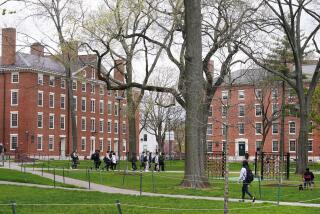High Marks for Mediocrity : Reliance on SAT Scores Has Inflated College Costs
- Share via
Today thousands of high school students all over the nation are taking the Scholastic Aptitude Test as a prerequisite for admission to college. Although the conclusion of this rite of academic passage will relieve these youngsters of some anxiety, a good case can be made that SATs, as well as such specialized instruments as the Law School Admission Test, should be abolished. And fortunately, a few colleges and universities around the nation have had the courage to drop the SAT requirement.
One compelling reason for dropping the test requirement is that the results often become self-fulfilling prophecies for those who obtain high scores. A good percentile ranking means entrance to a good university; at least, that’s the perception of students and academic administrators. Consequently, professors believe that their students are good, ergo , they don’t have to be great teachers to such a clientele, so they concentrate on research. The kids get a lousy education, rarely flunk out and believe that they have a corner on the professions as a result of an experience set in motion by a four-hour exam that they took in high school.
A not dissimilar mind-set prevails among civil-service employees, whose passing the federal or local examination has scarcely ensured a government employee system of which Americans can be proud.
In the 1960s when I began my full-time teaching career, academic institutions relied more heavily on open admissions policies on the grounds that a democratic nation ought to concern itself more with output (the student after four years of schooling) than with input (the credentials at the time of admissions). To be sure, there would always be the prestigious institutions that would rely on meritocracy, but the philosophy of the 1960s was antithetical to such elitism.
The problems of the decade--grade inflation, “relevant” courses that bore little relation to a typical curriculum, and the difficulty of ensuring literacy in a generation reared on television and oral communication--then seemed to become identified with the monster of open admissions, something that would be eradicated from the academic land.
The result was that some institutions began to employ the logic of businesses that produce expensive products: Raise both tuition and the quality of admissions standards. By mimicking the high-priced schools’ approach, such institutions hope to be considered “better” and thus make up for likely financial losses caused by the decrease in the college-age population.
The dilemma that participants in this scheme were loath to admit was that the range of increase in the SAT scores of admitted students was modest (putting most students in the wide middle) and thus was of dubious significance in designating the institution’s movement into the meritocracy. For such an institution to boast that the increase in scores was indicative of a new type of student was tantamount to passing off department-store shoes for Guccis.
There are other sound reasons for dropping entrance exams. Because they are under the purview of academicians rather than good writers, the reading and vocabulary sections of the exams are less an indication of a test-taker’s ability than they are a reflection of the author’s mode of expression, however wordy and unclear that might be. Moreover, if the exams measure aptitude and not what has been learned, then the impressive growth in prep courses would suggest that an enormous fraud is being perpetrated or that the test-makers’ secrets have, in fact, been discovered. Either way, the major beneficiaries are hardly the students, many of whom can ill afford to pay the fees for such courses.
Perhaps most important, entrance exam scores make it too easy for admissions committees to arrive at decisions on students. A decision to admit a student should be as thoughtful and searching an experience as the examination that a good professor would give to a class. That might involve interviews, discussions with former teachers or employers, as well as reviews of writing samples--methods that do not lend themselves to a machine-scored raw total.
Theologians in the Middle Ages did much to ruin their profession by making mountains out of molehills. (“How many angels can stand on the head of a pin?”) Teachers in ancient times did the same thing to truth by putting pebbles in the mouth of an alleged liar. If the pebbles came out dry, that was proof of a lie. In the contemporary quest for credentials and educational methods that rival those in the hard sciences, academic institutions should be wary of any litmus test that is likely to become more important than the value that can be added to a student’s learning experience.
More to Read
Sign up for Essential California
The most important California stories and recommendations in your inbox every morning.
You may occasionally receive promotional content from the Los Angeles Times.













